This post may contain affiliate links. Please read our disclosure policy.
Feta and Kale Fatayer are a delectable way to fill traditional Lebanese fatayer, little savory pies with all kinds of fillings. Try all My Best Lebanese Fatayer Recipes to explore the wonderful world of fatayer.
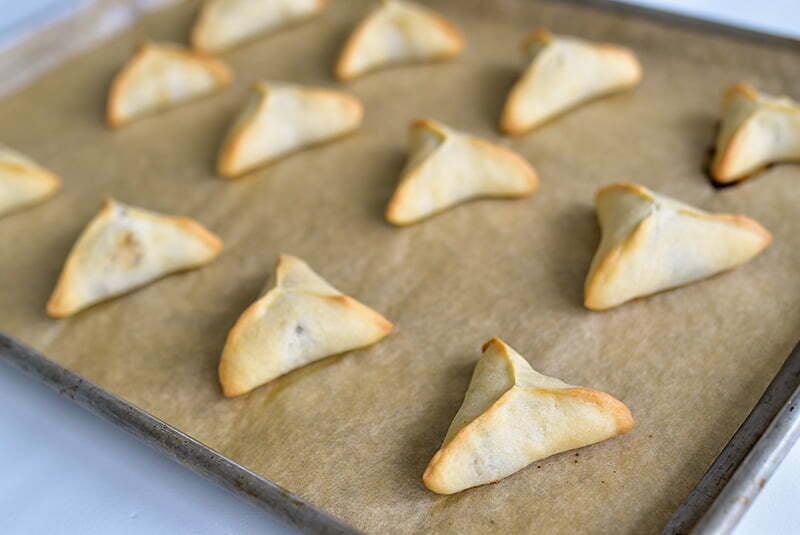
I’m still having relationship issues with fatayer, the little Lebanese pies that we all go crazy for.
First off, it’s bothered me that my spelling of fatayar is different than what I’m seeing elsewhere as “fatayer.” When I first started writing about Lebanese cuisine, there were so few doing it, so few established transliterations and spellings from Arabic. I mean, I don’t like to see my name spelled differently and I suspect my fatayar feels the same. So, as we go forward, we’re fatayer.
My plan was to present for us an all-cheese fatayer, perfectly boat shaped and with the right balance of crust to filling.

Now, recipe development is in my soul. It’s what I do and I love it. But this one? This one is far from ready.
The problems with creating a beautiful, balanced cheese fatayer boat are so many that I can’t go into it here and now. I’m too frustrated to talk. I’m giving it the silent treatment, however unhealthy that may be! I’m taking this style of fatayer to the mats, jujitsu style, until I dominate. More to follow when I do.

The filling.
Shifting gears, instead I present another triangle fatayer filled with tremendous texture and flavor. Baby kale subs in for spinach and I love the texture, the nutrients. Long ago my cousin Teresa told me she adds feta to her fatayer, and I’ve wanted to do same ever since. I can’t believe I waited this long! That salty, briney, deep flavor imparts a deliciousness only feta can achieve.
When I went hunting around to see if others in our sphere had made kale and feta fatayer, I found this. What fun to see how this absolute pro of a blogger had tapped into my fatayer-making methods and I had not even seen it when she published it back in 2017! Kathryn Pauline has a book coming out soon too, so we’ll be on the watch for that. Can’t wait.
The dough.
Part of my cheese fatayer endeavor includes a new dough. It’s soft, lovely, but still needs work to result in the thin crust we so desire in fatayer. For my feta kale, we’re sticking with the old school. My fatayer dough recipe just plain works. Especially if you follow the direction not to let the dough proof too long. I’m at less than 90 minutes, and it’s one rise only.

Rolling rolling rolling.
I continue to roll the dough, half at a time, to cut thin rounds from. I then have been pressing down the cut out round especially as they sit and start to expand. Down boy! And I mean flat please.
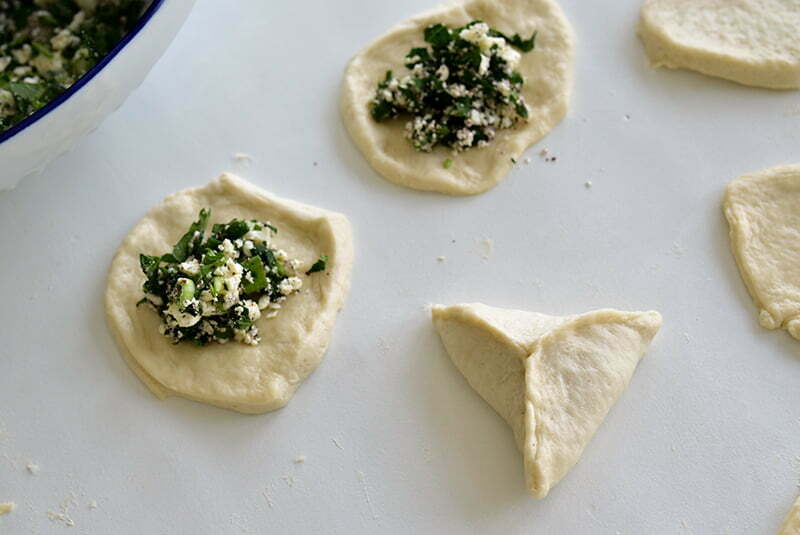

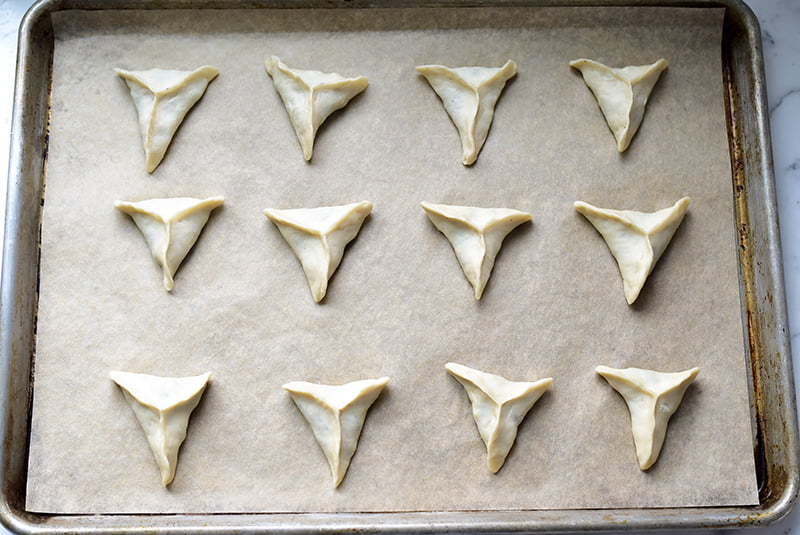
Placing the filling and pinching.
As I’ve noted in my success tips for fatayer, placement of the filling so it doesn’t get the perimeter of the dough circle wet is key. The feta kale filling is not damp at all, so that helps a ton.
Then, when you pull the dough up and over the filling to meet above center, pinch the H@$$ out of it. Then keep pinching until you have a seam that stands up in the three directions.
The fatayer sits on the sheet pan as you form the rest. It rises and starts to defy the seams, even if it doesn’t appear so. Therefore: pinch the seams again on each fatayer before baking, or at least pinch the middle connection point atop each fatayer.
Trust!
I know you’ll be waiting and wondering how cheese fatayer boats and I get along in the end. I’ll be sure to keep you posted on the drama.


Feta and Kale Fatayer
Ingredients
For the dough:
- 1 tablespoon active dry yeast
- 1 teaspoon granulated sugar or honey
- 1 cup warm water (80°-90°F)
- 3 cups unbleached, all-purpose flour
- 1 teaspoon kosher salt
- 1/3 cup neutral oil such as canola or safflower
For the filling:
- 2 cups chopped baby kale
- 7 oz. feta cheese, drained and finely crumbled
- 2 scallions, finely sliced
- 8 spearmint leaves, finely chopped
- 2 teaspoons sumac
Instructions
- Proof the yeast by dissolving it in ¼ cup of the warm water with the sugar. Set aside for about 10 minutes, or until the mixture looks frothy and creamy.
- Whisk together the flour and salt in a mixer bowl or medium bowl. Create a well in the center and add the oil and proofed yeast mixture. Using a stand mixer fitted with the hook attachment or by hand, slowly work the wet ingredients into the dry, adding 1/2 cup of the water slowly. Add more of the water only as necessary until the dough comes together and is cohesive.
- Knead the dough by hand or with the dough hook in the mixer until the dough is very soft, smooth, and tacky/sticky to the touch (but it should not leave dough on your fingers). Kneading by hand can be awkward at first because the dough is so wet, but as you knead, the dough will firm up a bit and absorb all of the water.
- In a clean bowl at least twice the size of the dough, lightly coat the dough and the sides of the bowl with oil. Cover the bowl (not the dough) with plastic wrap and set the dough aside to rise in a warm spot until doubled, one hour and not more than 90 minutes. Take care not to overproof the dough.
- While the dough rises make the filing. In a medium bowl, stir the kale, feta, scallion, mint and sumac until well combined.
- Heat the oven to 375°F. Line two heavy baking sheets with parchment paper or foil.
- Roll half of the dough out on a dry work surface to 1/8-inch thickness (see how here). Gently lift the dough from the edges to allow for contraction. Cut dough into 4-inch rounds. Knead together the scraps, cover with plastic, and set aside.
- Fill the rounds of dough by placing a heaping tablespoon of filling in the center of each round. Be careful not to let the filling touch the edges of the dough where it will be gathered together and closed. A good way to keep the filling in the center is to lower the spoon with the filling over the center of the dough (parallel to it) and use your fingers to slide the filling off the spoon and into the center of the dough circle. Be sure to wipe your fingers off before shaping to avoid kale specks on the dough.
- Bring three sides of the dough together in the center over the filling and pinch into a triangle. Close the dough firmly.
- Place the fatayar on the baking sheets and generously brush or spray the dough with olive oil. Bake in the middle of the oven for 18-20 minutes, or until golden brown. Set the oven on convection bake for the last 5 minutes, or place under the broiler, to encourage browning if needed.
- Repeat the process with the other half of the dough, then with the scraps that have been kneaded together and left to rest for a few minutes before rolling out.
Nutrition information is automatically calculated, so should only be used as an approximation.


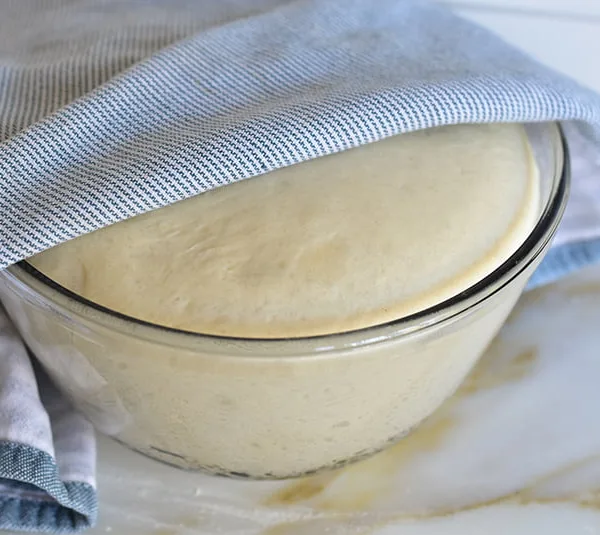
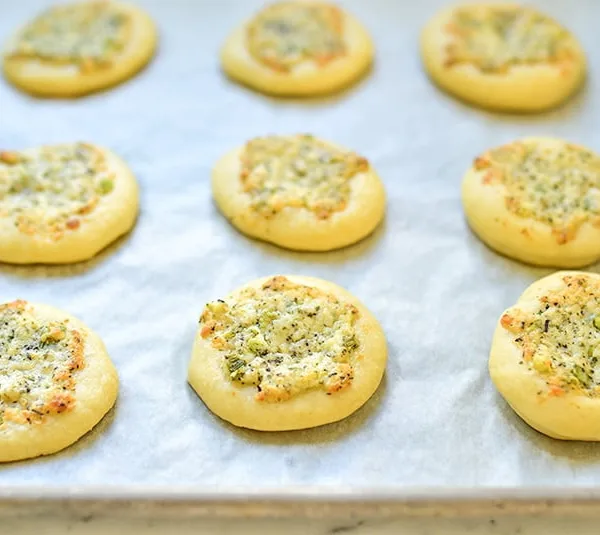







I have made (and loved!) your spinach fatayar before – but not the kale and feta. I’m looking forward to it! One note – I don’t see the salt amount on the ingredients for the dough? I am assuming it is the same dough recipe as the spinach one, which calls for 1 tsp kosher salt? Thank you!
Maureen thank you, recipe updated with that missed salt! Enjoy, delicious!
Hello.
Can you make them in advance and freeze them?
Yes absolutely. Bake them, then cool and freeze. Fatayer reheat beautifully once thawed, in a 300 degree oven for 10 minutes or so.
Thank you for the recipe! And love your blog!! Just found it!
My question has to do with the photo above the recipe. Lol
Do you recall what Color paint is on your wall in the photo?
Thanks! X
Thanks so much Maggie. The paint! Blue Veil by Benjamin Moore.
About how many does this recipe make? I know it’ll depend on how thinly the dough is rolled, but a ballpark idea would be nice. Thanks!
Yes of course! I see my serving number didn’t come through–updated now, thank you. 24 4-inch fatayer. Size also depends on the size of your round cutter. I typically use a 3- to 4-inch cutter. For small appetizer-sized fatayer, my cutter is 2.5-3 inches.